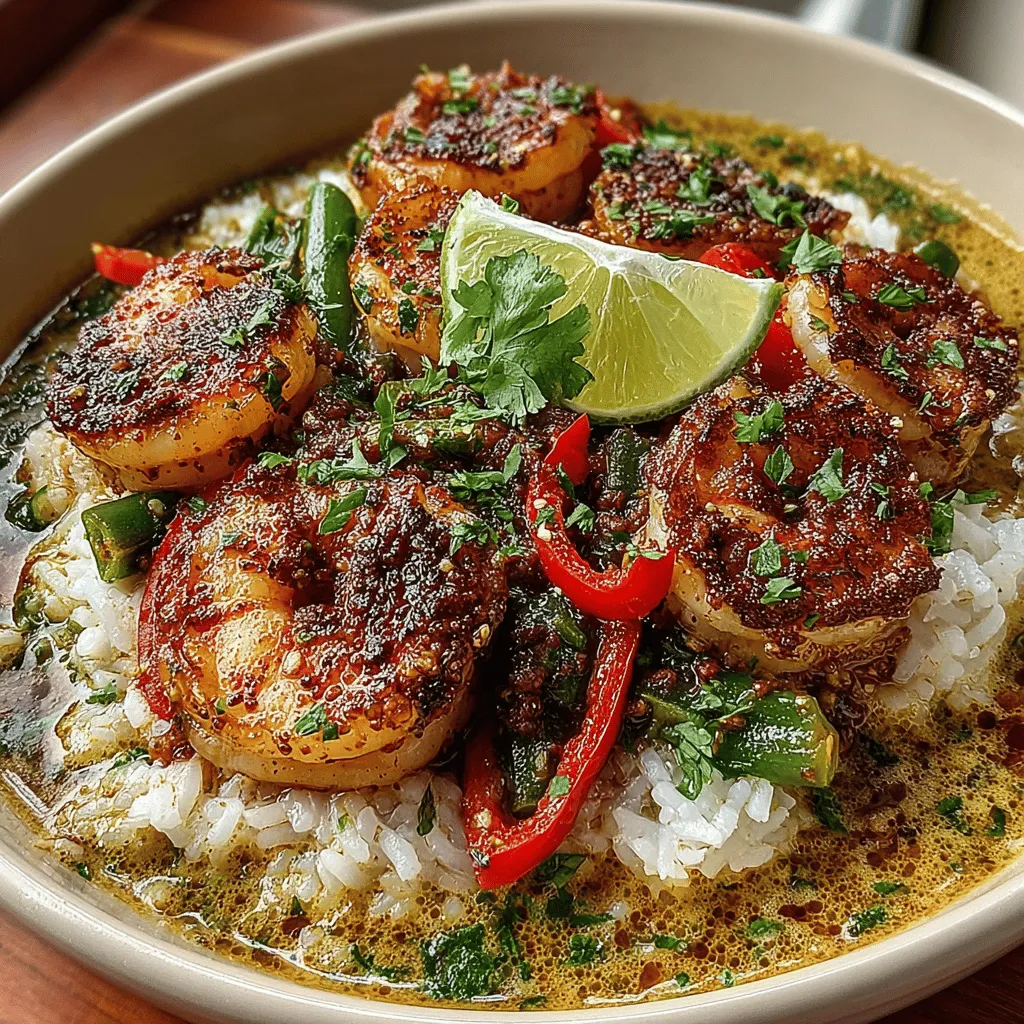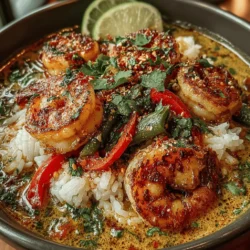Tropical flavors have an irresistible allure that transports you to sun-kissed beaches and lush landscapes. The Tropical Bliss Coconut Curry Shrimp recipe encapsulates this experience, combining vibrant ingredients with ease of preparation to create a dish that is both delightful and nourishing. With succulent shrimp, creamy coconut milk, and a medley of colorful vegetables, this recipe is a celebration of the tropics right in your kitchen. Not only is it a feast for the senses, but it also offers numerous health benefits, making it an excellent addition to your weekly meal rotation.
Ingredients
– 1 pound large shrimp, peeled and deveined
– 1 can (13.5 oz) coconut milk
– 2 tablespoons red curry paste
– 1 tablespoon olive oil
– 1 medium onion, diced
– 3 cloves garlic, minced
– 1 tablespoon fresh ginger, grated
– 1 bell pepper, sliced (red, yellow, or green)
– 1 cup snap peas, trimmed
– 1 tablespoon soy sauce or tamari
– 1 teaspoon lime juice
– Fresh cilantro, for garnish
– Cooked jasmine rice, for serving
Instructions
1. Begin by preparing the jasmine rice. Rinse 1 cup of jasmine rice under cold water until the water runs clear. In a medium saucepan, combine the rinsed rice with 1 3/4 cups of water and a pinch of salt. Bring to a boil, then reduce heat to low, cover, and simmer for 15-20 minutes until the rice is fluffy and the water is absorbed. Remove from heat and let it sit covered for an additional 5 minutes. Fluff with a fork before serving.
2. In a large skillet or wok, heat 1 tablespoon of olive oil over medium heat. Add the diced onion and sauté for 2-3 minutes until it becomes translucent.
3. Incorporate the minced garlic and grated ginger into the skillet, stirring frequently for about 1 minute until fragrant.
4. Add the sliced bell pepper and snap peas to the skillet. Cook for another 3-4 minutes, allowing the vegetables to soften while maintaining their vibrant color.
5. Stir in the red curry paste, ensuring it evenly coats the vegetables. Cook for an additional minute to release the flavors.
6. Pour in the coconut milk and stir well to combine. Allow the mixture to come to a gentle simmer.
7. Add the peeled and deveined shrimp to the skillet. Cook for 3-5 minutes, or until the shrimp turn pink and opaque. Be careful not to overcook them.
8. Season the curry with soy sauce or tamari and lime juice. Stir well and adjust seasoning to taste.
9. Serve the Tropical Bliss Coconut Curry Shrimp over the fluffy jasmine rice and garnish with fresh cilantro.
Understanding the Key Ingredients
Shrimp as a Versatile Protein Source
Shrimp is not only delicious but also a versatile protein that can be incorporated into various dishes. It is low in calories and high in protein, making it a great choice for those looking to maintain a healthy diet. When sourcing shrimp, consider sustainability practices to ensure you’re making an environmentally conscious choice.
The Role of Coconut Milk in Cooking
Coconut milk is a staple in many tropical cuisines, contributing a rich, creamy texture and a subtle sweetness to dishes. It is a great alternative for those who are lactose intolerant, as it contains healthy fats that can be beneficial for heart health. The creamy nature of coconut milk enhances the overall flavor profile of the curry, making it a crucial ingredient.
Red Curry Paste: A Flavor Powerhouse
Red curry paste is a blend of ingredients such as red chili peppers, garlic, lemongrass, and galangal. This paste is packed with flavor and can vary in heat levels, allowing you to customize your dish according to your spice preference.
Fresh Produce: The Importance of Vegetables in the Dish
Incorporating fresh vegetables like bell peppers and snap peas not only adds color and texture but also boosts the nutritional value of the dish. These vegetables are rich in vitamins and minerals, making your meal wholesome and satisfying.
Tips on Selecting and Preparing Fresh Produce
When selecting vegetables, look for vibrant colors and firm textures. For the best flavor, prepare your vegetables just before cooking to maintain their freshness and nutritional content.
Step-by-Step Cooking Instructions
To achieve the perfect Tropical Bliss Coconut Curry Shrimp, start with the preparation of jasmine rice, as it complements the curry beautifully. Follow the detailed cooking method for the shrimp base, ensuring that each ingredient is prepared and cooked to enhance the overall flavor of the dish.
By focusing on these key elements, you will create a delightful meal that is not only easy to prepare but also packed with nutritional benefits.

Tips for Perfecting Tropical Bliss Coconut Curry Shrimp
The Significance of Layering Flavors
Layering flavors is essential in creating a rich and complex dish like Tropical Bliss Coconut Curry Shrimp. Start by sautéing aromatic ingredients such as garlic, ginger, and onions to build a solid foundation. This initial step enhances the overall taste and ensures that each ingredient contributes to the final flavor profile. As you add in vegetables and curry paste, continue to taste and adjust, allowing each layer to shine through.
Adding Vegetables and Curry Paste
When adding vegetables, consider using a mix of colors and textures to enhance both the visual appeal and the nutritional value of the dish. Bell peppers, snap peas, and zucchini are excellent choices that not only complement the shrimp but also add crunch and freshness.
Tips for Maintaining Vibrant Colors and Textures in Vegetables
To keep vegetables bright and crisp, add them at different stages of cooking. For instance, hardy vegetables like carrots can be added earlier, whereas delicate greens should be introduced toward the end. Cooking them just until tender will preserve their color and crunch.
How to Properly Incorporate Curry Paste for Optimal Flavor
When incorporating curry paste, start with a smaller amount and gradually add more to suit your taste preferences. Sautéing the curry paste with your aromatics helps release its essential oils, enhancing the dish’s overall flavor. Stir it well to ensure it coats all the ingredients evenly.
Incorporating Coconut Milk and Final Seasoning
Coconut milk is the heart of this dish, providing creaminess and a subtle sweetness that balances the spices. When adding coconut milk, stir to blend it fully with the other ingredients, allowing it to simmer gently to thicken without boiling.
Techniques for Achieving a Well-Balanced Sauce
For a well-balanced sauce, taste frequently and adjust the seasoning as needed. A touch of salt, sugar, or additional curry paste can elevate the flavors further. Remember to keep the heat low to avoid curdling the coconut milk.
The Role of Lime Juice and Fish Sauce in Enhancing Flavor
Lime juice and fish sauce are critical for adding depth and brightness to your curry. The acidity from lime juice helps cut through the richness of the coconut milk, while fish sauce introduces a savory umami note. Add these ingredients at the end of cooking to maximize their flavors.
Cooking the Shrimp to Perfection
For perfectly cooked shrimp, pay attention to their color and texture. Cook them just until they turn pink and opaque, which typically takes only a few minutes.
Signs That Shrimp Are Cooked Properly
The shrimp will curl slightly and become firm to the touch when cooked. Be careful not to overcook them, as this can result in a rubbery texture.
How to Avoid Overcooking Shrimp
To avoid overcooking, remove the shrimp from heat as soon as they are done and allow them to finish cooking in the residual heat. Keeping a close eye during this final stage is crucial for achieving the perfect bite.
Serving Suggestions
Presentation Ideas for Serving Tropical Bliss Coconut Curry Shrimp
For an appealing presentation, serve your curry in a shallow bowl, allowing the vibrant colors of the dish to take center stage. Garnish with freshly chopped cilantro, lime wedges, and a sprinkle of red chili flakes for an added pop of color and flavor.
How to Create an Appealing Dish with Garnishes
Garnishes not only enhance the visual appeal but also contribute to the tasting experience. Consider adding toasted coconut flakes or crushed peanuts for texture and additional tropical flair.
Side Dish Pairings that Complement the Curry
Pair your Tropical Bliss Coconut Curry Shrimp with fresh salads, steamed jasmine rice, or crusty bread to soak up the delicious sauce. A light, citrusy salad can provide a refreshing contrast to the richness of the curry.
Suggested Beverages that Pair Well with the Dish
To complement the tropical flavors, consider serving your meal with refreshing beverages such as coconut water, iced tea, or a mango lassi. These drinks will enhance the dining experience and keep the theme consistent.
Nutritional Analysis
Breakdown of Calories and Macronutrients Per Serving
Each serving of Tropical Bliss Coconut Curry Shrimp typically contains around 300-400 calories, depending on the portion sizes and ingredients used. It offers a balanced mix of protein from the shrimp, healthy fats from coconut milk, and carbohydrates from vegetables.
Comparison with Other Popular Shrimp Recipes
Compared to other shrimp recipes, this dish stands out for its use of coconut milk and fresh vegetables, offering a unique flavor profile while still being a healthy option.
Discussion on the Health Benefits of a Balanced Meal
This recipe is packed with nutrients, as shrimp are a great source of lean protein and omega-3 fatty acids, while the variety of vegetables contributes vitamins and minerals essential for overall health.
Conclusion
Tropical Bliss Coconut Curry Shrimp is a delightful and easy dish that can elevate your weeknight dinners with its vibrant flavors and colorful presentation. This recipe invites experimentation, allowing you to adapt it to your personal taste preferences. Embrace the joy of cooking with fresh, tropical ingredients and share this flavorful meal with loved ones for a memorable dining experience.

